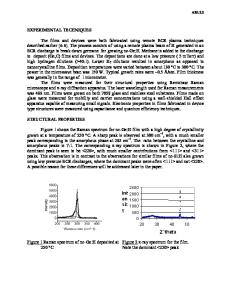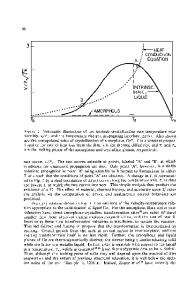Structure of Germanium Monoxide Thin Films
- PDF / 1,223,592 Bytes
- 6 Pages / 612 x 792 pts (letter) Page_size
- 10 Downloads / 280 Views
LECTRONIC PROPERTIES OF SEMICONDUCTORS (ATOMIC STRUCTURE, DIFFUSION)
Structure of Germanium Monoxide Thin Films K. N. Astankovaa,*, V. A. Volodina,b, and I. A. Azarova,b a Institute
of Semiconductor Physics, Siberian Branch, Russian Academy of Sciences, Novosibirsk, 630090 Russia b Novosibirsk State University, Novosibirsk, 630090 Russia *e-mail: [email protected] Received August 24, 2020; revised August 28, 2020; accepted August 28, 2020
Abstract—By optical methods (Raman spectroscopy, infrared spectroscopy, X-ray photoelectron spectroscopy) and electron-microscopy techniques, it was found that the atomic structure of germanium monoxide films of stoichiometric composition corresponds to the random bonding model and does not contain germanium nanoclusters. This structure is metastable and transforms into a random mixture structure at a temperature of 260°C and higher. The metastability of solid GeO can be caused by internal strains in the atomic network. Keywords: germanium monoxide, metastability, random bonding model DOI: 10.1134/S1063782620120027
1. INTRODUCTION Previous studies have shown that germanium oxides (GeO2 and GeOx) can offer promise for the production of memristors due to a high density of defects (oxygen vacancies) that play the role of traps for charge carriers [1, 2]. It is assumed that, in germanium oxides, the memristive effect is associated with the formation and annihilation of conductive filaments of oxygen vacancies under changes in the sign of the control voltage [3]. In addition, germanium inclusions in GeOx can act as deep traps for electrons and holes [4]. To gain a sophisticated understanding of the nature of the memristive effect, it is necessary to know the structure of GeOx. In contrast to comprehensively studied germanium and germanium dioxide [5], practically nothing is known about the structure of solid germanium monoxide because of its metastability [6, 7]. It is known that, at T > 200°C, germanium monoxide starts to decompose with the formation of a heterophase system consisting of a GeO2 insulating matrix with Ge nanoclusters [8] and, at T > 400°C, germanium monoxide can evaporate in the form of GeO gas [9]. Consequently, in the course of studying GeO films, an external action (heating, irradiation with an electron, ion, or photon beam) can induce their decomposition or evaporation [10, 11]. According to the data reported in publications, germanium monoxide is amorphous [12, 13]. In some studies, the amorphous structure of germanium monoxide and its insolubility in water are attributed to its possible polymeric nature [13]. Vasyutinskií et al. [6] reported that they managed to produce germanium monoxide in the form of a powder. Its crystals were
shaped as planar squares, rectangles, and less often parallelograms. The set of crystal-optical data suggests that the crystals belong to the lowest crystal system (probably the monoclinic one). Martynenko et al. [7] synthesized a germanium monoxide powder that was found to be a crystalline diamagnetic material. From the viewpoint of
Data Loading...









